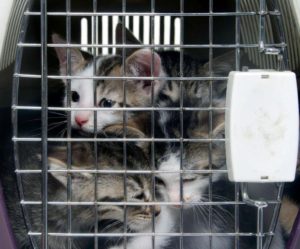Get to know these few tips on how to take your pet along as a passenger.
It is so adorable to see a cute little doggie sitting quietly in a car and staring out the window as his owner zips by on the highway. That heartwarming sight gets you wondering if you can do that with your own little precious fluff of fur.
Visions of strolling down a pet-friendly park where your big dog can run free flash through your mind, or maybe you can see your little baby sitting prettily in a pet satchel, popping her head up occasionally to give a tiny meow (yes, why not bring a cat if it’s well-behaved?) as you take her shopping.

These are all possible, as more and more establishments are now setting themselves up to be pet-friendly. The first challenge would be: how to get your pretty little baby out there. Here are some tips on how to take your pet on a road trip:
1. Take baby steps. If you are planning to go on a long haul trip, it’s a good idea to start small. Acquaint your pet with the concept of riding in a moving vehicle. Days before your outing, go out on short distances, such as around the block in your car. This will help you observe how he behaves, which will then help you gauge whether you need to put your pet in a crate or carrier.
2.Feed your pet just right. Don’t overfeed your pet before a car trip. Even if he is already used to long journeys, there is still a possibility of car sickness. A light meal three or four hours before the trip is ideal.
3. Don’t feed your pets while you’re on the move. Keep water intake at the right levels too, so there are fewer chances that your pet will need to pee while in transit.
4. Shake it off. Take your dog for a short walk or play with your kitty before your trip begins. This will help to calm him down and work off all the excess energy. If you are taking long trips, stop every two hours to stretch your legs―and those of your pet. Never forget to bring a leash or harness though so that your pet doesn’t accidentally run away!
5. Keep safety in mind. If you think your dog will be overly excited or anxious in the vehicle, it is better to use a crate. A cat is also better off boxed in, to prevent it from running loose and getting under your car pedals. Under no circumstances should you have your pet in the front seat or worse, on your lap when you drive. This is very distracting and therefore, very unsafe. You might want to invest in a pet harness for your car, especially if you plan to take frequent road trips with your furry co-pilot.
6. Pack it in. Some of the things you need to bring are food, a bowl, an extra leash, a pooper scooper, plastic bags, and, of course, water. You may opt to bring a favorite chew toy or a blanket to ease boredom and anxiety. If you are putting your pet in a carrier, make sure to bring along extra lining.

7. Close that window. While the quintessential image of pet on the road may be that of a cute dog with its snout hanging out the car window, experts advise that it is best to just blast that air-conditioning if your pet needs it, and keep the windows closed. Airflow and road debris (not to mention Metro Manila pollution) can irritate your pet’s eyes and nose. There have also been instances where pets simply jump out the window in pursuit of something they see; you don’t want your pet to be the subject of another sad story. While you’re at it, employ a child-lock on the doors and windows.
8. Zip and click. If you choose not to use a crate, don’t just leave your pet free to wander about in your car. There are pet seatbelts that connect your dog’s harness to a regular car seatbelt. However, restraining devices should never be attached to a dog’s collar.
9. Never leave your pet in the car alone. Even if the window is open or even for just a “few minutes,” this is an absolute, total no-no that is considered animal abuse. Temperatures can rise quickly inside a parked car and this can cause heatstroke.
10. Cover up. Often, the only reason why cats get to ride in a car is to go to the vet, so keep your cat calm by covering the carrier with a light cloth. Arrange the cloth so that your cat can see you, if possible, but not out the windows. According to the PETA website, the sight of the earth or sky speeding past causes most cats to panic, begin open-mouthed breathing, and howl miserably.
11. Be patient. Your dog or cat may either become anxious or overexcited, and may begin to bark, howl, meow, cry, or even try to escape their carriers. Remember that your pet is not human and that being in a vehicle can be a very scary experience for it. He or she isn’t doing that to irritate you; it is a genuine emotion, and you owe it to your pet to understand how they feel.
This story appeared in Animal Scene’s March 2015 issue.






